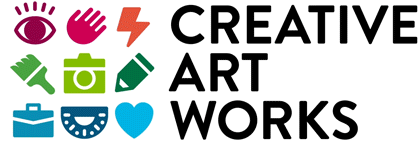Doing the Right Thing
Doing the Right Thing
Students in a Social Justice Class discuss a collage about racism by one of their peers.
“Go over to each painting with your group and look at it. What do you think the theme or message is?” asks Carla Cherry, gesturing to thirteen student artworks posted around the classroom. “Now some paintings have obvious messages, while others you might not have a clue. See if you can figure it out.”
Carla teaches a class in Social Justice at Innovations Diploma Plus High School, a transfer school on the Upper West Side. NYC Transfer schools are small, full-time high schools designed to re-engage students who have dropped out or fallen behind in credits but who are still determined to earn a high school diploma. This past semester, Creative Art Works Teaching Artist Ashli Sisk taught an integrated art program, in collaboration with Ms. Cherry, designed to complement the class' readings and discussions of No Disrespect by the hip-hop artist and activist Sister Souljah.
“I started as an English teacher in 1999, and this event has got to go down as one of the most memorable and powerful learning experiences I have witnessed as an educator.. I simply have to infuse more art programs like this into my school.”
Ashli and Carla asked their students to choose a social justice issue that resonated with them and create a photo-essay or painting that illustrated their message or theme. The issues ranged from timeless to topical. At a two-day culminating event last week, all thirteen students presented their work to their peers and outside visitors. We hope you enjoy reading excerpts from selected presentations below.
Gentrification
Harlem was once a safe haven for ethnic cultures, but now things are getting too expensive... So, I took a photo of an older white lady and I put A. Phillip Randolph’s face on her body, and I put the white lady's face on the Harriet Tubman statue. I was trying to represent black culture being pushed out or trying to conform to white culture.
— Zoe
Racism in the Fashion Industry
Everybody knows what’s going on with Gucci and all these other fashion labels, right? I wanted to show that a lot of people don't care about how racist these high-end brands are. That’s the reason why [the figure] doesn’t have eyeballs, because people are blind to the facts, or they say, ‘whatever.’ And the $900 price tag is because they'll spend $900 on anything, because they only care about the price and the hype.
— Emmerson
Homelessness
The different colors represent the rollercoaster of emotions one goes through while struggling with homelessness. I put this picture of a protest march here, because I would like to see everybody coming together, raising money, to find suitable homes for the homeless. This quote says, "Even when I was homeless, I stayed in school." And this little boy with a backpack on represents all the homeless kids that stay in school, and I put question marks all over him. [All this] is to show you can go through your struggles but you can still become something in life.
— Kalen
Affordable Housing
There are certain people who struggle to either pay their rent or actually buy a house or try to have a better living, but it's hard because sometimes it's too expensive. I chose these different pictures to show different living places and the different environments where people live. Manhattan is not that expensive to certain people, but to other people it is.
— Deborah
LGBTQ Rights
I chose dark colors for my painting, because it represents how some [LGBTQ] people are getting killed, or raped, or kicked out of their family home, because of how we label ourselves. And I'm frustrated, because we get treated differently from how heterosexual people get treated. We get treated like we don't have emotions.
— Jorge
Racial Discrimination
Everybody comes in different shapes and sizes, and we all get divided and put into a category, and we all get made fun of because of our race and how we look. But we’re all similar in many ways. We're really all the same.
— Emmanuel






